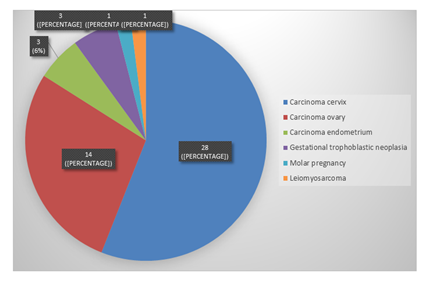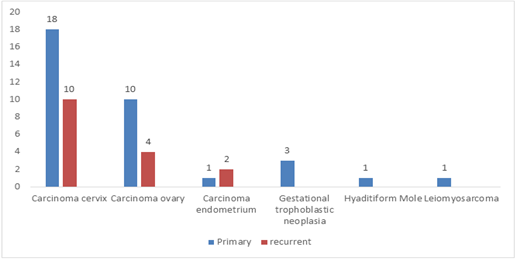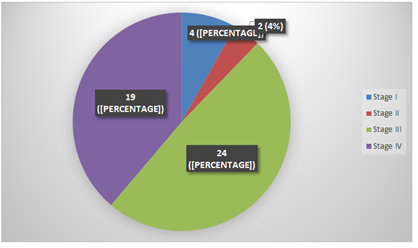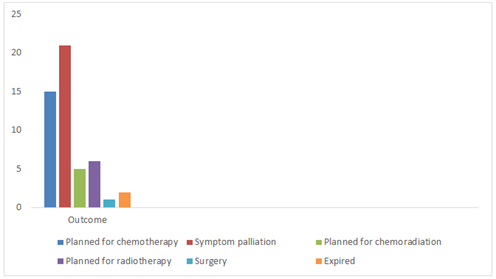Treatment Outcome of Patients with Gynaecological Cancer Presenting to Emergency Department of A Tertiary Care Hospital
Article Information
Kumari S*
Department of Obstetrics and Gynaecology, All India Institute of Medical Sciences, New Delhi, India
*Corresponding Author: Dr. Sarita Kumari, Department of Obstetrics and Gynaecology, All India Institute of Medical Sciences, New Delhi, India
Received: 25 March 2020; Accepted: 16 April 2020; Published: 27 April 2020
Citation: Kumari S. Treatment Outcome of Patients with Gynaecological Cancer Presenting to Emergency Department of A Tertiary Care Hospital. Journal of Cancer Science and Clinical Therapeutics 4 (2020): 091-099
View / Download Pdf Share at FacebookAbstract
Introduction: Patients with Gynaecological malignancies frequently visit the Emergency Department (ED). Knowledge of clinical presentation and their acute management will help in delivering a better care to these patients.
Materials and Methods: A Cross sectional study was conducted in the ED of All India Institute of Medical Sciences New Delhi, India from January 1, 2018 to December 31, 2018. The study cohort comprised of fifty patients with gynaecological cancer. Inpatient medical record was evaluated.
Results: Median age of fifty patients was 45.5 years (range 18 - 68). Carcinoma cervix was the most common malignancy (28 cases, 56%) followed by carcinoma ovary (14 cases, 28%), carcinoma endometrium (3 cases, 6%), gestational trophoblastic neoplasia (3 cases, 6%), molar pregnancy (1 case, 2%) and leiomyosarcoma (1 case, 2%). Predominant complaints were pain (28%), anuria (22%), bleeding per vaginum (22%) and shortness of breath (14%). Obstructive uropathy was the most common diagnosis (26%) followed by anaemia (18%), electrolyte imbalance (14%) and intestinal obstruction (14%). Bilateral percutaneous nephrostomy and electrolyte correction were the commonest intervention in 12 cases each (24%) followed by antifibrinolytics in 11 cases (22%), pain management in 10 cases (20%) hemodialysis in 9 cases (18%), blood transfusion in 8 cases (16%). Median length of hospital stay was 48 hours (6 – 96 hours). Six patients underwent emergency laparotomy. Of fifty patients two (4%) expired during the stay.
Conclusion: Pain was the commonest presentation and appropriately managing pain is a significant contributor to improving quality of life in these patients.
Keywords
Gynaecological cancer; Emergency management; Pain and palliation; Treatment outcome
Gynaecological cancer articles, Emergency management articles, Pain and palliation articles, Treatment outcome articles
Gynaecological cancer articles Gynaecological cancer Research articles Gynaecological cancer review articles Gynaecological cancer PubMed articles Gynaecological cancer PubMed Central articles Gynaecological cancer 2023 articles Gynaecological cancer 2024 articles Gynaecological cancer Scopus articles Gynaecological cancer impact factor journals Gynaecological cancer Scopus journals Gynaecological cancer PubMed journals Gynaecological cancer medical journals Gynaecological cancer free journals Gynaecological cancer best journals Gynaecological cancer top journals Gynaecological cancer free medical journals Gynaecological cancer famous journals Gynaecological cancer Google Scholar indexed journals Emergency management articles Emergency management Research articles Emergency management review articles Emergency management PubMed articles Emergency management PubMed Central articles Emergency management 2023 articles Emergency management 2024 articles Emergency management Scopus articles Emergency management impact factor journals Emergency management Scopus journals Emergency management PubMed journals Emergency management medical journals Emergency management free journals Emergency management best journals Emergency management top journals Emergency management free medical journals Emergency management famous journals Emergency management Google Scholar indexed journals Pain and palliation articles Pain and palliation Research articles Pain and palliation review articles Pain and palliation PubMed articles Pain and palliation PubMed Central articles Pain and palliation 2023 articles Pain and palliation 2024 articles Pain and palliation Scopus articles Pain and palliation impact factor journals Pain and palliation Scopus journals Pain and palliation PubMed journals Pain and palliation medical journals Pain and palliation free journals Pain and palliation best journals Pain and palliation top journals Pain and palliation free medical journals Pain and palliation famous journals Pain and palliation Google Scholar indexed journals Treatment outcome articles Treatment outcome Research articles Treatment outcome review articles Treatment outcome PubMed articles Treatment outcome PubMed Central articles Treatment outcome 2023 articles Treatment outcome 2024 articles Treatment outcome Scopus articles Treatment outcome impact factor journals Treatment outcome Scopus journals Treatment outcome PubMed journals Treatment outcome medical journals Treatment outcome free journals Treatment outcome best journals Treatment outcome top journals Treatment outcome free medical journals Treatment outcome famous journals Treatment outcome Google Scholar indexed journals Carcinoma cervix articles Carcinoma cervix Research articles Carcinoma cervix review articles Carcinoma cervix PubMed articles Carcinoma cervix PubMed Central articles Carcinoma cervix 2023 articles Carcinoma cervix 2024 articles Carcinoma cervix Scopus articles Carcinoma cervix impact factor journals Carcinoma cervix Scopus journals Carcinoma cervix PubMed journals Carcinoma cervix medical journals Carcinoma cervix free journals Carcinoma cervix best journals Carcinoma cervix top journals Carcinoma cervix free medical journals Carcinoma cervix famous journals Carcinoma cervix Google Scholar indexed journals carcinoma endometrium articles carcinoma endometrium Research articles carcinoma endometrium review articles carcinoma endometrium PubMed articles carcinoma endometrium PubMed Central articles carcinoma endometrium 2023 articles carcinoma endometrium 2024 articles carcinoma endometrium Scopus articles carcinoma endometrium impact factor journals carcinoma endometrium Scopus journals carcinoma endometrium PubMed journals carcinoma endometrium medical journals carcinoma endometrium free journals carcinoma endometrium best journals carcinoma endometrium top journals carcinoma endometrium free medical journals carcinoma endometrium famous journals carcinoma endometrium Google Scholar indexed journals gestational trophoblastic neoplasia articles gestational trophoblastic neoplasia Research articles gestational trophoblastic neoplasia review articles gestational trophoblastic neoplasia PubMed articles gestational trophoblastic neoplasia PubMed Central articles gestational trophoblastic neoplasia 2023 articles gestational trophoblastic neoplasia 2024 articles gestational trophoblastic neoplasia Scopus articles gestational trophoblastic neoplasia impact factor journals gestational trophoblastic neoplasia Scopus journals gestational trophoblastic neoplasia PubMed journals gestational trophoblastic neoplasia medical journals gestational trophoblastic neoplasia free journals gestational trophoblastic neoplasia best journals gestational trophoblastic neoplasia top journals gestational trophoblastic neoplasia free medical journals gestational trophoblastic neoplasia famous journals gestational trophoblastic neoplasia Google Scholar indexed journals molar pregnancy articles molar pregnancy Research articles molar pregnancy review articles molar pregnancy PubMed articles molar pregnancy PubMed Central articles molar pregnancy 2023 articles molar pregnancy 2024 articles molar pregnancy Scopus articles molar pregnancy impact factor journals molar pregnancy Scopus journals molar pregnancy PubMed journals molar pregnancy medical journals molar pregnancy free journals molar pregnancy best journals molar pregnancy top journals molar pregnancy free medical journals molar pregnancy famous journals molar pregnancy Google Scholar indexed journals leiomyosarcoma articles leiomyosarcoma Research articles leiomyosarcoma review articles leiomyosarcoma PubMed articles leiomyosarcoma PubMed Central articles leiomyosarcoma 2023 articles leiomyosarcoma 2024 articles leiomyosarcoma Scopus articles leiomyosarcoma impact factor journals leiomyosarcoma Scopus journals leiomyosarcoma PubMed journals leiomyosarcoma medical journals leiomyosarcoma free journals leiomyosarcoma best journals leiomyosarcoma top journals leiomyosarcoma free medical journals leiomyosarcoma famous journals leiomyosarcoma Google Scholar indexed journals cancer treatment articles cancer treatment Research articles cancer treatment review articles cancer treatment PubMed articles cancer treatment PubMed Central articles cancer treatment 2023 articles cancer treatment 2024 articles cancer treatment Scopus articles cancer treatment impact factor journals cancer treatment Scopus journals cancer treatment PubMed journals cancer treatment medical journals cancer treatment free journals cancer treatment best journals cancer treatment top journals cancer treatment free medical journals cancer treatment famous journals cancer treatment Google Scholar indexed journals
Article Details
1. Introduction
Cancer patients frequently visit emergency department (ED) in the late stages of disease. It acts as a critical portal to address acute illness issues. Approximately two-thirds of ED visits by patients with cancer end in hospital admission [1, 2]. ED care is focused on symptom control and management of the adverse effects of cancer treatment. Retrospective studies have described patient characteristics presenting to the ED and common complaints included pain, respiratory and gastrointestinal symptoms [1, 3-7]. A retrospective study done at an oncology centre in Ethiopia stated that most common malignancy in female was gynaecological (47%) followed by breast (26%). Carcinoma cervix was the most common among all gynaecological malignancies to present in ED (8). It is important to assess treatment outcome of cancer patients treated in ED. In this study we aim to analyse the presentation, diagnosis and treatment outcome of gynaecological cancer patients visiting the ED.
2. Material and Methods
We conducted a cross sectional study in the Emergency Department of All India Institute of Medical Sciences New Delhi from January 1, 2018 to December 31, 2018. Study was conducted as per principles of Declaration of Helsinki. This hospital provides a tertiary level referral treatment and it is opened for 24 hours for emergency services. The study cohort comprised of all Gynaecological cancer patients which included cervical, ovarian, uterine and gestational trophoblastic malignancies. All participants provided written informed consent. In the ED, inpatient medical record of all patients was evaluated. Exclusion criteria included pregnancy and not willing to participate. Study variables included age, type of cancer, stage, presenting symptoms and diagnosis, emergency treatment received, further plan of care and outcome. Data was analyzed using SPSS software (version 18.0, SPSS, inc, Chicago, IL) and included descriptive statistics such as mean, percentage, proportion and frequency. Fifty patients were included in the analysis.
3. Results
Median age of fifty patients was 45.5 years (range 18-68). Distribution of patients as per type of malignancy is shown in Figure 1.

Figure 1: Distribution of fifty patients as per type of malignancy.
Carcinoma cervix was the most common (28 cases, 56%) followed by carcinoma ovary (14 cases, 28%), carcinoma endometrium (3 cases, 6%), gestational trophoblastic neoplasia (3 cases, 6%), molar pregnancy (1 case, 2%) and leiomyosarcoma (1 case, 2%). Among the twenty eight patients of carcinoma cervix, eighteen (64%) were treatment naive and ten (36%) were recurrent cases. Among fourteen cases of carcinoma ovary, five (36%) were treatment naive, four (28%) were recurrent and five (36%) were germ cell tumors. Of three cases of carcinoma endometrium, two (67%) were recurrent cases. Figure 2 shows the overall distribution of primary or recurrent cases.

Figure 2: Distribution of fifty cases as treatment naive (primary) or recurrent.
Stage distribution of carcinoma cervix cases was sixteen (57%) stage III B, six (21%) stage IVA and six (21%) stage IVB. Among carcinoma ovary cases, two (14%) were stage I, seven (50%) stage III C, two (14%) stage IVA and three (21%) stage IV B. Two (67%) carcinoma endometrium cases were stage I and one (33%) was stage II. Among gestational trophoblastic neoplasia one case each was in stage II, III and IV respectively. Leiomyosarcoma case was in stage IVB. Overall stage distribution is shown in Figure 3.

Figure 3: Stage distribution of fourty nine patients (excluding Hyaditiform mole).
Presenting complaints of cases are depicted in Table 1.
|
Presenting symptom |
Frequency, n (percentage, %) |
|
Pain |
14 (28) |
|
Anuria |
11 (22) |
|
Bleeding per vaginum |
11 (22) |
|
Shortness of breath |
7 (14) |
|
Not passed flatus and stool |
6 (12) |
|
Abdominal distension |
5 (10) |
|
Nausea and vomitting |
4 (8) |
|
Lower limb swelling |
3 (6) |
|
Altered sensorium |
3 (6) |
|
Dizziness |
3 (6) |
|
Blood in urine |
2 (4) |
|
Urine leaking form vagina |
1 (2) |
|
Blood in sputum |
1 (2) |
|
Jaundice |
1 (2) |
|
Headache |
1 (2) |
|
Fever |
1 (2) |
|
Seizures |
1 (2) |
|
Maggots in perineum |
1 (2) |
ED= Emergency department
Table 1: Presenting symptoms of fifty cases of Gynaecological cancer in ED.
Pain was the predominant complain followed by no urine output, bleeding per vaginum, shortness of breath, not passes flatus or stool, abdominal distension, nausea and vomiting, lower limb swelling, altered sensorium, dizziness and blood in urine. One case each had urinary leak from vagina, blood in sputum, jaundice, headache, fever, seizures and feeling of insects (maggots) crawling in the perineum.
Diagnosis was made by the emergency team which are enlisted in Table 2.
|
Diagnosis |
Frequency, n (percentage, %) |
|
Obstructive uropathy/uraemia |
13 (26) |
|
Anaemia |
9 (18) |
|
Electrolyte imbalance |
7 (14) |
|
Intestinal obstruction |
7 (14) |
|
Metabolic acidosis |
5 (10) |
|
Lung metastases |
4 (8) |
|
Pleural effusion |
3 (6) |
|
Ascites |
3 (6) |
|
Tumor rupture and hemoperitoneum |
2 (4) |
|
Adnexal torsion |
2 (4) |
|
Lung collapse |
2 (4) |
|
Hematuria |
2 (4) |
|
Deep vein thrombosis |
1 (2) |
|
Sepsis |
1 (2) |
|
Septic shock |
1 (2) |
|
Pneumonia |
1 (2) |
|
Vesicovaginal fistula |
1 (2) |
|
Sciatic nerve involvement by tumor |
1 (2) |
|
Bone metastases |
1 (2) |
|
Brain metastases |
1 (2) |
|
Displaced PCN |
1 (2) |
|
Carcinoma cervix with maggots |
1 (2) |
ED= Emergency department, PCN= Per cutaneous nephrostomy
Table 2: Diagnosis of fifty patients with Gynaecological cancer in ED.
Carcinoma cervix cases had obstructive uropathy, anaemia, electrolyte imbalance, metabolic acidosis, lung metastases, hematuria, deep vein thrombosis, sepsis, septic shock, vesicovaginal fistula, sciatic nerve involvement, bone metastases, displaced PCN and/or maggots in perineum. Carcinoma ovary cases presented with ascites, pleural effusion, lung collapse, tumor rupture and hemoperitoneum and/or adnexal torsion. Carcinoma endometrium cases had pneumonia or intestinal obstruction. Gestational trophoblastic neoplasia cases had anaemia, lung and/or brain metastases. Leiomyosarcoma patient had lung metastases and collapse.
Management in emergency comprised of hyperkalaemia correction, hypokalemia correction, hemodialysis, bilateral per cutaneous nephrostomy (PCN), antifibrinolytics, blood transfusion, pain management, intravenous antibiotics, nagogastric tube insertion, nil per oral and intravenous fluids, emergency laparotomy (intestinal resection and anastomosis in one case), therapeutic ascitic tapping, drainage of pleural effusion, intercostal chest tube insertion, anticoagulation, seizure control by phenytoin, urinary bladder irrigation, ionotropes, hemostatic radiotherapy, vaginal packing, PCN repositioning, intubation, cardiopulmonary resuscitation, local debridement and turpentine oil. These findings are depicted in Table 3.
|
Management in ED |
Frequency, n (percentage %) |
|
Hyperkalaemia correction |
8 (16) |
|
Hypokalaemia correction |
4 (8) |
|
Hemodilaysis |
9 (18) |
|
Bilateral PCN |
12 (24) |
|
Antifibrinolytics |
11 (22) |
|
Blood transfusion |
8 (16) |
|
Pain management |
10 (20) |
|
Intravenous antibiotics |
6 (12) |
|
Nagogastric tube insertion, nil per oral and intravenous fluids |
6 (12) |
|
Emergency laparotomy |
6 (12) |
|
Therapeutic ascitic tapping |
3 (6) |
|
Drainage of pleural effusion |
1 (2) |
|
Intercostal chest tube insertion |
1 (2) |
|
Anticoagulation |
1 (2) |
|
Seizure control by phenytoin |
1 (2) |
|
Urinary bladder irrigation |
2 (4) |
|
Ionotropes |
2 (4) |
|
Hemostatic radiotherapy |
2 (4) |
|
Vaginal packing |
1 (2) |
|
PCN repositioning |
1 (2) |
|
Intubation |
1 (2) |
|
Cardiopulmonary resuscitation |
1 (2) |
|
Local debridement and turpentine oil |
1 (2) |
ED= Emergency department, PCN= Per cutaneous nephrostomy
Table 3: Management of fifty patients of Gynaecological cancer in ED.
Median length of hospital stay was 48 hours (6-96 hours). Patients were discharged after planning a definitive therapy i.e. chemotherapy (30%), palliation of symptoms (42%), chemoradiation (10%), radiotherapy (12%) and surgical evacuation in the case of hyaditiform mole. Six patients underwent emergency laparotomy, with adnexal torsion, tumor rupture with hemoperitoneum and intestinal obstruction identified in two cases each. Of fifty patients two (4%) expired during the stay. Treatment outcome at the time of discharge is depicted in Figure 4.

Figure 4: Treatment outcome of fifty patients at the time of discharge.
One case was a sixty five year old with stage IIIB carcinoma cervix who presented with altered sensorium and anuria. She had metabolic acidosis and obstructive uropathy with serum urea and creatinine level of 120 and 17 mg/dl respectively. She was administered cardiopulmonary resuscitation for fourty five minutes but could not be revived. Another mortality was that of a fifty six year old with stage IV B leiomyosarcoma uterus, post surgery and post chemotherapy and radiotherapy. She had shortness of breath with lung metastases and collapse. She was intubated and started on supportive care but she expired after 22 hours of stay.
4. Discussion
Around 3% of all ED population of patients are with a diagnosis of cancer [9]. They present in an acute state with high symptom burden, and frequent need for admission. In the study by Rivera DR et al, 4.2% of all cases were cancer patients [3]. There are no prior reports exclusive to gynaecological cancer patients. An Australian report by Livingston PM et al showed Gynecologic cancer on fifth place (2.5% of all cases) whereas in another report by Sisay F et al., gynecological cancers comprised 11.7% of all oncological cases and was the third most common [10, 11].
Carcinoma cervix was the most frequent malignancy (56%) to present in ED and in an advanced stage. This is similar to another study by Wondimagegnehu T et al done in Ethiopa in which carcinoma cervix was the most common among all gynaecological malignancies to present in ED [8].One third of the cases were recurrent tumor in present study. Pain, anuria and bleeding per vaginum were the predominant symptoms and patients had obstructive uropathy, anaemia, electrolyte imbalance, metabolic acidosis, lung metastases, hematuria, deep vein thrombosis, sepsis, septic shock, vesicovaginal fistula, sciatic nerve involvement, bone metastases, displaced PCN and/or maggots in perineum. Carcinoma ovary cases presented with ascites, pleural effusion, lung collapse, tumor rupture and hemoperitoneum and/or adnexal torsion. Carcinoma endometrium cases had pneumonia or intestinal obstruction. Gestational trophoblastic neoplasia cases had anaemia, lung and/or brain metastases. Leiomyosarcoma patient had lung metastases and collapse.
The main complain among all patients was pain (28%). This is similar to other studies in oncology patients. 40% in the study by Swenson KK et al. 15.2% in the study by Gianmauray N et al, 22.9% in the study by Ahn S et al. [12-14]. In our study other common complaints were anuria (22%), bleeding per vaginum (22%), shortness of breath (14%), not passed flatus or stool (12%) and abdominal distension (10%). In a study by Christian E et al conducted in Germany, Austria and Switzerland; bleeding, nausea, vomiting and fever were common after pain [15].
Symptomatic treatment was started in all patients and definite management plan was made after consultation with oncology and palliation team. Two patients expired during the course of treatment and both were in terminal stages of their disease. There is a need for improved symptom control before and during the ED visit. Since Pain is the commonest presentation among patients with cancer and appropriately managing pain is a significant contributor to improving quality of life in these patients. Timely specialty consultation and adequate outpatient follow-up for further management is a prerequisite to decrease further ED visits in a decompensated state.
5. Conclusion
Across all malignancies, gynecological cancer contributes a major proportion to ED visits with carcinoma cervix being the commonest. Active intervention is required since the majority present in an acute state and pain being the commonest presenting symptom. Outcomes largely depend on acute management in ED and timely speciality consultation for further symptom palliation and management of primary cause.
Funding
None
Disclosure of Interest
No conflicts of interest to disclose.
References
- Mayer DK, Travers D, Wyss A, et al. Why do patients with cancer visit emergency departments? results of a 2008 population study in North Carolina. J Clin Oncol 29 (2011): 2683-2688.
- Vandyk AD, Harrison MB, Macartney G, et al. Emergency department visits for symptoms experienced by oncology patients: a systematic review. Support Care Cancer 20 (2012): 1589-1599.
- Rivera DR, Gallicchio L, Brown J, et al. Trends in adult cancer-related emergency department utilization: an analysis of data from the Nationwide Emergency Department Sample. JAMA Oncol 3 (2017): e172450.
- Yang C, Murray WB, Lindstrom DJ, et al. Development and validation of the performance of airway management instrument for paramedics. Ann Emerg Med 62 (2013): S76.
- Oatley M, Fry M, Mullen L. A cross-sectional study of the clinical characteristics of cancer patients presenting to one tertiary referral emergency department. Int Emerg Nurs 24 (2016): 35-38.
- Sadik M, Ozlem K, Huseyin M, et al. Attributes of cancer patients admitted to the emergency department in one year.World J Emerg Med 5 (2014): 85-90.
- Panattoni L, Fedorenko C, Greenwood-Hickman MA, et al. Characterizing potentially preventable cancer and chronic disease-related emergency department use in the year after treatment initiation: a regional study. J Oncol Pract 14 (2018): e176-e185.
- Wondimagegnehu T, Abera M, Aynalem A. Pattern of Cancer in TASH Oncology Center in Ethiopia from 1998-2010. International Journal of Cancer Research and Molecular Mechanism 1 (2015).
- Brown J, Grudzen C, Kyriacou DN, et al. The emergency care of patients with cancer: setting the research agenda. Ann Emerg Med 68 (2016): 706-711.
- Patricia M, Melinda C, Monica S. Clinical and economic Burden of emergency department presentation for neutropenia following out patient’s chemotherapy for cancer in Victoria, Australia. The Oncologist 17 (2010): 998-1004.
- Sisay F, Kebede S, Abebe A, et al. Treatment outcome of oncologic patients treated in emergency department at black lion specialized hospital, Ethiopia. J Integr Oncol 7 (2018): 213.
- Swenson KK, Rose MA, Ritz L, et al. Recognition and evaluation of oncology related symptoms in the emergency department. Ann Emerg Med 26 (1995): 12-17.
- Gianmauro N, Antonella C, Alessandro M, et al. Hospital admission of cancer patients: Avoidable practice or necessary care?. Plos One 10 (2015).
- Elmar C, Irinaeus A, Normann W, et al. Radiotherapy in oncology emergency final result of pattern of case study In Germany, Australia and Switzerland. Acta Oncol 47 (2008): 81-89.
- Ahn S, Lee YS, Lim KS, et al. Emergency department cancer unit and management of oncologic emergency: experience in Asian medical center. Support Care Cancer 20 (2012): 2205-2210.
